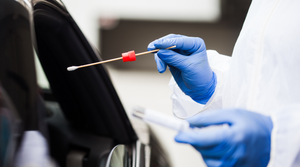Bonding Nonfluorinated Elastomers Directly to Fluoropolymers
Two dissimilar polymers can be bonded together without the need for a surface-preparation, adhesive, heat-shrink, or etching step.
March 10, 2014
Used in diagnostic and surgical applications, catheters perform a host of functions. And depending on the application, they are made from different materials or different combinations of materials. Among the many materials used for manufacturing catheters, Parsippany, NJ–based Evonik Corp., together with Orangeburg, NY–based Daikin America Inc., have developed polymer formulations with dissimilar properties, enabling a coextrusion process that eliminates the need for extra processing steps.
|
A direct-bonding process creates a coextrusion consisting of a PEBA outer layer and an EFEP interior layer. |
“Among the spectrum of material possibilities, incompatible materials provide the best balance of properties,” remarks Suneel Bandi, senior application developer at Evonik Corp. “However, to make coextrusions from incompatible materials, manufacturers must be able to adhere them together.” Adhering dissimilar materials, he says, can be achieved in many different ways: by using an adhesive, heat-shrinking or etching the materials, or direct-bonding them. Each method, he adds, has its own advantages and disadvantages.
PEBA and EFEP
In contrast to other coextrusion methods, the new process relies on Evonik’s Vestamid Care modified polyether block amide (PEBA) and Daikin’s Neoflon modified fluorinated ethylene-propylene copolymer (EFEP), both of which have direct-bonding capabilites. PEBA, according to Bandi, is a block copolymer of soft polyether segments and hard PA12 segments. Because of their very low glass transition temperature, polyether sequences are frequently referred to as soft blocks, while the crystalline PA 12 sequences are known as hard blocks. Together, both the soft and hard blocks offer a good balance of rigidity and flexibility, making them suitable for catheter applications.
Among all of the polyamides, PA 12 exhibits the lowest water absorption capacity, a characteristic that provides for high dimensional stability and good mechanical properties. These traits are evident in the various grades of PEBA. And because of the polyamide segment, this material provides good chemical and solvent resistance and also resists punctures. Biocompatible grades of PEBA are available with Shore D hardness ranging from 40 to 71, which can be adjusted based on the specific composition of the material.
For multilayer catheter applications in which adhesion is desired, a chemically modified PEBA can be used. In such configurations, the material still exhibits Shore D hardness ranging from 40 to 71, but it incorporates additional functionality that enables it to bond to other polymers.
Fluoropolymers such as Daikin America’s EFEP contain built-in functional groups, allowing it to react with the modified PEBA. During the coextrusion process, the functional groups in the EFEP react with those in the modified PEBA, resulting in permanent chemical bonding at the interface, explains Keith Shih, a senior scientist at the Daikin Technical Center. This capability eliminates the needs for an extra etching step and enables manufacturers to bond the materials without applying an adhesive layer between them. EFEP possesses a low coefficient of friction and a low melting temperature, in addition to exhibiting chemical and heat resistance and good barrier performance. The grade of EFEP recommended for coextrusion applications, RP-5000, exhibits a melting temperature of approximately 195°C, making it compatible with PEBA.
Direct Coextrusion Process
Consisting of PEBA and a fluoropolymer, traditional multilayer catheters are constructed in several different manual steps, according to Bandi. The first step involves the extrusion of a fluoropolymer over a wire mandrel, after which the fluoropolymer is etched. Next, successive layers of PEBA and reinforcements are built on top of the fluoropolymer core, and then a final layer of heat-shrinkable fluoropolymer is added on top of the entire construction. The construction is then exposed to heat, causing all of the underlying layers to reflow. After the construction has cooled, the mandrel and the heat-shrink layers are removed, leaving the finished catheter. In such constructions, the process of bonding the different layers requires either a separate surface preparation step or the use of an adhesive.
“Unlike nonadhesive fluoropolymers, Daikin’s EFEP can be bonded to other materials,” Shih says. “During the coextrusion process, the modified PEBA material is bonded directly to the EFEP material, eliminating the need for a surface-preparation, adhesive, heat-shrink, or etching step. The processing temperatures of both resins are similar enough to allow coextrusion of the PEBA and EFEP without the need to change many of the extrusion parameters.”
Based on the ultimate property requirements for the end-use application, manufacturers produce catheters from different types of materials, Bandi notes. Because no single material can address all of the property requirements for all catheter applications, manufacturers try to find the right combinations of materials to meet the end-catheter requirement. “The advantage of combining dissimilar materials in a coextrusion process, he adds, is that because it eliminates the need for additional processing steps, it increases manufacturing efficiency and helps to lower costs.”
Bob Michaels is senior technical editor at UBM Canon.
You May Also Like



